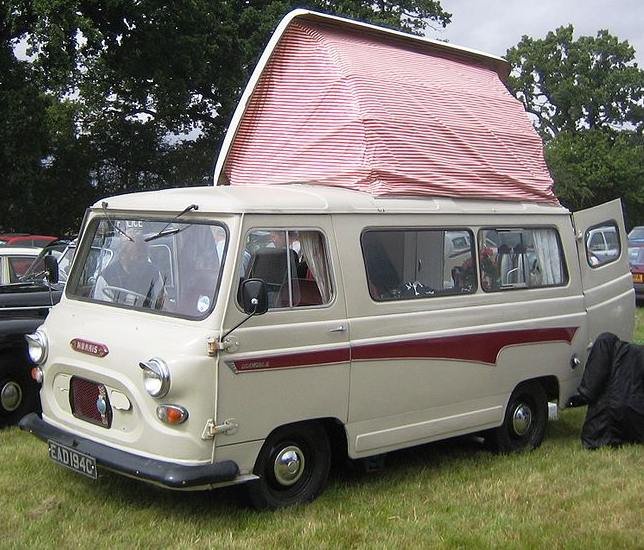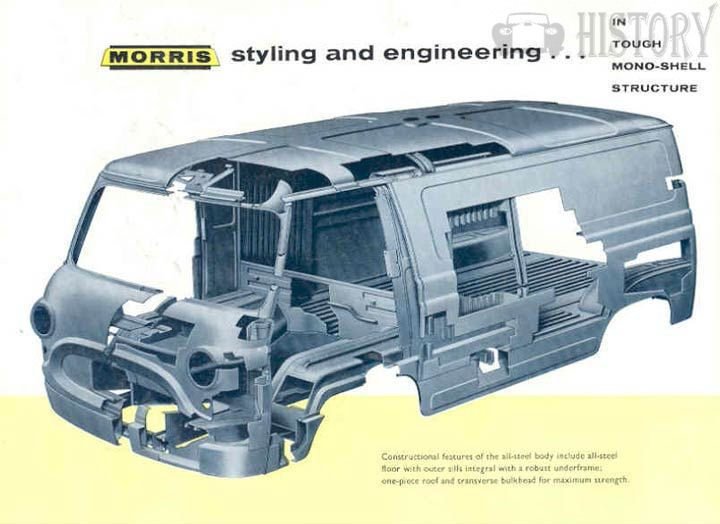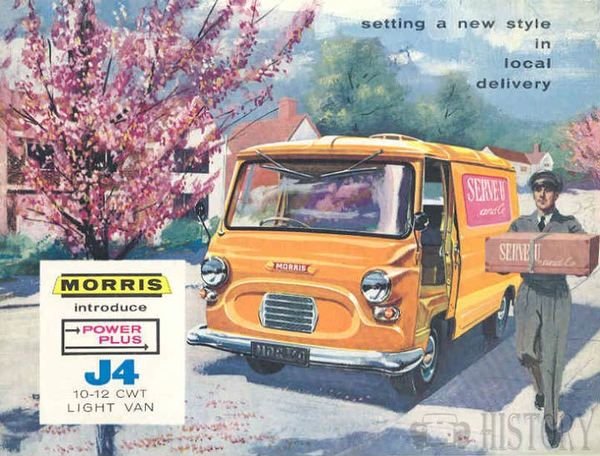Morris J4 van
| 1960 to 1974 | |
|---|---|
 |
|
| Overview | |
| Manufacturer | Morris Commercial |
| Also called | Austin J4 Morris 10/12 cwt |
| Production | 1960 – 1974 |
| Body and chassis | |
| Class | Van |
| Dimensions | |
| Length | 162 in (4,115 mm) |
| Width | 69 in (1,753 mm) |
| Height | 81 in (2,057 mm) (approx) |
| Chronology | |
| Predecessor | Morris Commercial J-type Morris Commercial J2 |
| Successor | Leyland Sherpa |
The Morris Commercial J4 was a 10 cwt (0.5 ton) forward control van (driver's cab on top of the engine) launched by the Morris Commercial subsidiary of the British Motor Corporation (BMC) in 1960 and produced with two facelifts until 1974, available with the familiar B series petrol engine in 1622cc form and also, at extra cost, with a 1500 cc diesel unit. Stopping power came from drum brakes all round: there was no servo assistance. Suspension was similar to that on the Austin Cambridge/Morris Oxford of the time: the front independent suspension incorporated coil springs and hydraulic "Lever-type" shock absorbers while the rear springing was achieved by semi-elliptic leaf springs.
In the 1960s light vans were often named simply by their load capacity, and the van at the time was often called simply the Morris 10/12 cwt. (The "cwt" - pronounced "hundredweight" - is an imperial unit of weight much used in Britain at the time and equivalent to approximately 50 kg:, these names therefore denoted a load capacity of 500/600 kg. There was also a US cwt but this had a different value.)
The van was marketed first as both the Morris J4 and the Austin J4. Following the formation of the British Leyland Motor Corporation in 1968, into which BMC, by then a subsidiary of British Motor Holdings, had been absorbed, the van was branded as the BMC J4.

1961 Morris J4 Van 4 body X-ray view
During its life the van underwent minor improvements under the metal. However, even in 1967 the vans were still shipped with synchromesh on the top three forward gears onlyThe engine lived in the driver's cabin between the two seats: the van was considered unusually noisy, even in the 1960s. A J4 petrol engined based motor caravan was tested by Britain's Autocar magazine in 1967. It managed a maximum speed of 63 mph (101 km/h) and a time from 0-50 mph (80 km/h) of 20.2 seconds. The vehicle as tested weighed 2,910 pounds (1,320 kg) and overall petrol consumption for the test came in at 22.7 mpg-imp (12.4 L/100 km; 18.9 mpg-US).
This van became a familiar sight on British streets collecting and delivering mail in the Royal Mail livery of the Post Office. Although quite a successful light commercial, it sold mainly by virtue of keen pricing to large fleets, living after 1965 in the shadow of the all conquering front engined Ford Transit, as did several other British built 60s/70s light commercials such as the Leyland Atlas, Commer FC and the formerly class leading but now ageing Bedford CA. Indeed whilst competent as a van the Morris J4 offered a rather poor driving experience even by the standards of the day.
The J4 was replaced in 1974 by the front engined Sherpa van, which utilised the rear panel work of the J4 virtually unchanged, this remaining in production in various forms until 2006.
Popular culture
A London Metropolitan Police J4 (usually referred to as a Black Maria) appears parked in the street on the cover of the Beatles Abbey Road

Technical
-
Morris J4 Technical details and specifications (1960-1974)
1.6L petrol B series Engine
No. of cylinders Type 4/OHV
Capacity 1622cc
Compression ratio 8,3:1
Suitable for unleaded petrolNo
Fuel system Make SU Type HS2 Carb-VV
Ignition coil Make Lucas Type LA12
Firing order 1-3-4-2
Distributor Make Lucas No. 25D4 41282
Contact breaker gap 0.4mm
Dwell angle 57-63° (63-70%)
Fuel pump delivery pressure 0,14-0,27 bar© Motor car History
Service
-
Morris J4 Maintenance and Service Guide (1960-1974)
1.6L petrol B series Engine
Spark plugs 0,8 mm
Spark plugs Tighten 35 Nm
Spark plugs Original equipment Champion type RN9YCC
Valve clearance -INLET 0,40mm cold
Valve clearance -EXHAUST 0,40mm cold
Engine oil grade - moderate climate 15W/40SAE
Engine oil change with filter 4,96 litres
Cooling system 5,4 litres© Motor car History
